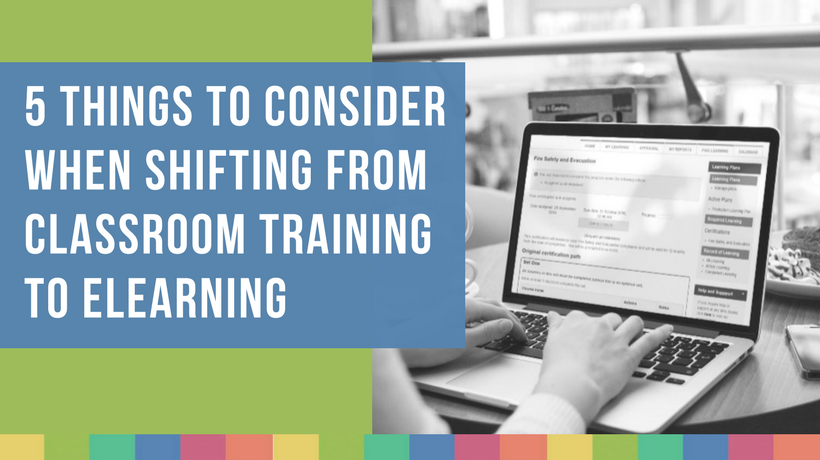
Considering transitioning from classroom training to eLearning but concerned about the process? Here are five key considerations when doing your research and implementing the online training.
1. Virtual location and access
Traditional classroom training consists of a physical format. This can be beneficial for office-based staff but restrictive to field-based or part-time staff, for example. When adopting online training, consider all employees and ensure they can gain access with ease.
You should aim to find a mobile-ready platform. This will allow employees to complete learning on mobile devices such as tablets and phones. This will particularly help those who are home-based or learners that prefer to complete training on the go.
Are there any issues with virtual learning? Sometimes, employees that prefer to learn kinaesthetically may not gel with online learning. This is because they may usually prefer learning in a face-to-face environment with an instructor. However, it’s a common myth that eLearning cannot live up to the same expectations. There are many techniques that can be adopted with eLearning to ensure that this style of learner is accommodated for. This could be the inclusion of discussion boards or ‘chats’ on the learning management system. This will ensure there is a line of communication open for employees to discuss different learning topics.
2. Replicating classroom training
If you mainly offer classroom training, then PowerPoints, a teacher and textbooks are likely to be common devices. It often comes as a surprise to eLearning-newbies that this can be easily replicated in an engaging way via eLearning.
Replicating content can help bridge the gap for those that are used to learning face-to-face. Learning Management Systems (LMSs) like Totara Learn has the functionality to upload documents alongside online learning modules. This allows learners to upload extra evidence of learning. This could involve uploading a signed policy document or a certificate of classroom training. Functionality like this allows organisations to adopt a sophisticated blended approach. This learning method allows you to continue to monitor and record classroom training whilst benefiting from eLearning.
If your employees are used to engaging and interactive classroom training, then you should make sure your eLearning has the same qualities. You can achieve this by picking eLearning courses that use a variety of techniques to engage learners. It can be as simple as using your organisation’s brand colours or gamified learning to captivate your staff.
3. Assessment and feedback
Capturing feedback and assessing learners is vital to classroom training. However, this is no different for online training. Face-to-face learners are told what they will cover, how they are progressing, what they should do next and their thoughts of the experience. Online training can and should do the same thing.
All good quality eLearning courses will highlight learning outcomes at the beginning, allowing learners to digest the content. Assessments can be added throughout to track the progress of the learner whilst a final assessment provides the required compliance data.
It’s also important to gain feedback from your learners. You may currently hand out an evaluation sheet post-classroom session. In a similar way, surveys can be added to the end of eLearning courses. You’ll learn if the eLearning is suitable for your employees or if there are any improvements to be made.
4. Cost savings
Some organisations choose to switch to online training for convenience or flexibility, but a key advantage is cost-effectiveness. Classroom training can become costly with the lecturer, the admin time and training materials.
In comparison, eLearning is affordable to set up and will have minimum maintenance costs depending on the LMS and eLearning provider you choose. To add value to your eLearning presence, obtaining a authoring tool license. This will also allow you to make amends to current eLearning courses or create your own from scratch.You’ll be able to fill skill gaps quicker and cheaper in comparison to face-to-face training.
More importantly, converting basic classroom training into eLearning allows your trainers to focus on more sophisticated learning requiring face-to-face interaction.
5. Jumping the gun
Whilst introducing eLearning can be an exciting process, take your time when researching providers. Access plenty of LMS demos and eLearning courses to find the right fit for your organisation.
Once you’ve decided on a provider, it’s even more important to get training on your chosen LMS. There will be lots to play with, but defining the key required functions will allow your LMS provider to teach you the essentials. Consider whether your provider will offer free ongoing training and support through online webinars or a support desk, for example.
As you get to know your LMS, you are going to want to utilise further functionality or perform more sophisticated tasks. A benefit of choosing an open-source platform, such as Totara Learn, is the large community of users. The ‘Totara Community’ is full of resources, guides and documents that helps users with their queries.
There are unique benefits to classroom training and eLearning. What’s important is that Learning Management Systems have developed so dramatically throughout the years that they no longer need to exist separately. Adopting an LMS such as Totara Learn will allow you to bring together the two learning formats to co-exist and complement each other.
If you’re interested in replacing classroom training content with eLearning and would like to discuss how Learning Nexus can help, please contact us.
